The Ten Tracks
| Track | Album |
|---|---|
| Fight For Your Right | Licensed To Ill |
| Shake Your Rump | Paul’s Boutique |
| B-Boy Bouillabaisse | Paul’s Boutique |
| So What’cha Want | Check Your Head |
| Something’s Got To Give | Check Your Head |
| Bodhisattva Vow | Ill Communication |
| Sabotage | Ill Communication |
| I Don’t Know | Hello Nasty |
| Intergalactic | Hello Nasty |
| Too Many Rappers | Hot Sauce Committee Part Two |
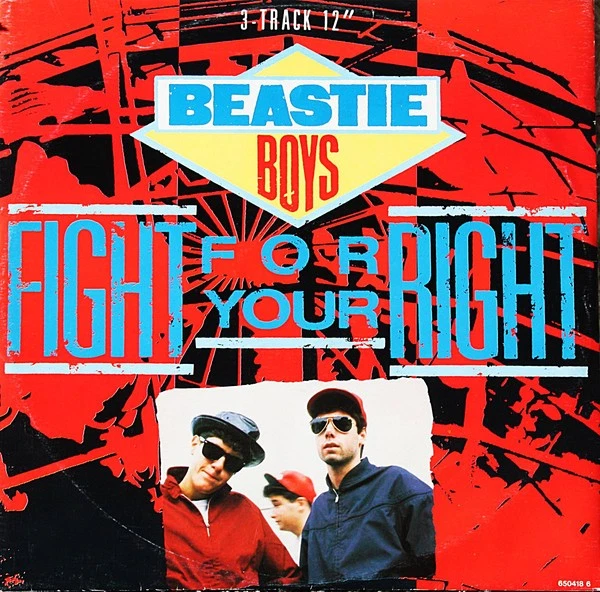
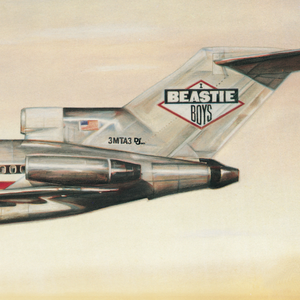
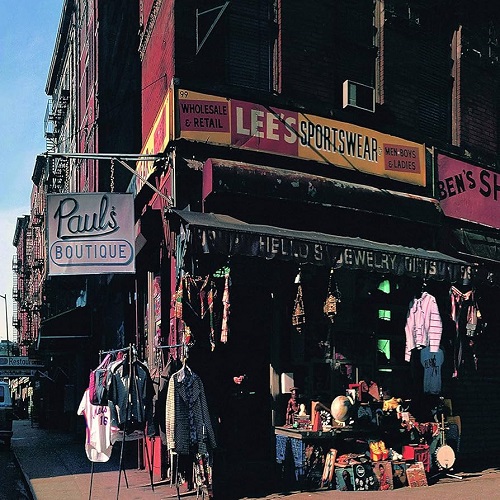
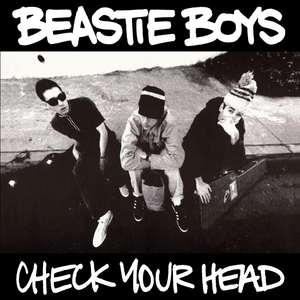
The explanation
There are very few bands that you can say you grew up with. There’s lots of music that I grew up with; records my mum played while doing the housework, records that Noel Edmonds played while I got ready for primary school, records older cousins played me: Elvis, the Beatles, David Bowie, Frank Sinatra, the Pistols etc etc but none of them really belonged to me, they were records that were handed down by other generations.
The Beastie Boys are a couple of years older than me and over the years we’ve kind of evolved together. From teenage days where fun was the point regardless of how it affected others, to settling into a gentler more empathetic middle age, it’s been quite a journey.
Once again picking ten records has been a near impossible task, and I’m not going to say that these are the definitive tracks by the Beasties. What they do though is help plot a timeline that’ll take us from an anxious kid on the school bus, to a husband and father sitting on a comfy sofa who wishes he could tell the kid on the bus that everything will be great in the end.
I really liked John Peel and the evening DJs at Radio One. They opened my ears to a huge variety of music away from the mainstream but the DJ who had the strongest influence on my teenage listening was Mike Allen at Capital Radio.
Mike looked like a typical mid 80s pop radio DJ (think Smashie and Nicey or Alan Partridge) but between 1984 and 1987 he was one of the few people in the UK regularly playing Electro/Rap/Hip Hop on the radio. I can’t remember how I first came across his show. I was probably just idly scanning through the radio but once I found it I was hooked. His show was the first place I heard Run DMC, Afrika Bambaataa, Public Enemy and, eventually, the Beastie Boys.
Like most people, my introduction to the Beasties was Fight For Your Right. Mike Allen played it one Friday night late in 1986 and it sounded like nothing else on his show. Most early hip hop was based around drum machines and synths, or break beats lifted from obscure 70s funk. Fight For Your Right bludgeoned you over the head with metal guitar riffs lifted straight from producer Rick Rubin’s record collection. The next day a friend and I made our way to Groove Records in Soho and somehow managed to afford to scrimp together enough cash to get a copy of Licensed To Ill on import. By the time Fight For Your Right got in the charts and the Beasties had become UK tabloid bogeymen, we’d been listening to it for months. I had just turned 17 when the album came out and it was the perfect soundtrack for overly impressionable suburban kids indulging in underage drinking and horrible behaviour.
The song eventually became a millstone for the band setting an image of them that some people still think of when their name is mentioned. Initially intended as a parody of the jock and frat boy lifestyle, it became something that overtook them; night after night three middle class New Yorkers would take to the stage and conduct a beer-swilling riot, like an awful fancy dress party that they were unable to escape from.
Looking back at the time, Mike D said, “The only thing that upsets me is that we might have reinforced certain values of some people in our audience when our own values were actually totally different. There were tons of guys singing along to Fight For Your Right who were oblivious to the fact it was a total goof on them.”
The album had been hugely successful and obviously Def Jam was keen for a sequel, more of the same, a Licensed To Ill part two. Something the Beasties had just about zero interest in doing. MCA (Adam Yauch) in particular felt that his own ideas were being swamped by Rick Rubin, and the word among the record industry was that Beastie Boys were nothing more than a hip hop version of the Monkees, frontmen for Rubin’s genius. A couple of years went by and the Beasties drifted apart, not breaking up, just taking a breather. You’d occasionally read in the music papers that Ad-Rock was making a film in Hollywood, or that MCA was busy with a side project in Brooklyn, but musically the Beasties were apparently yesterday’s men.
Estranged from Def Jam they signed a deal with Capitol and in July 1989 a new album Paul’s Boutique was released. The label had high hopes for a repeat performance of the debut album, and despite an initial fanfare and push by Capitol the album flopped. For some it was just too much of a change. For a start it was less frantic, a far more languid affair, the pace dictated as much by marijuana consumption as by a conscious change of direction. My first encounter with the record was seeing the video for Shake Your Rump on late night MTV.
As with Fight For Your Right it grabbed me immediately – rock riffs exchanged for squelchy synths, funky drums, and latin instrumentation. If Licensed To Ill was dominated by Rick Rubin’s record collection, Paul’s Boutique was a perfect concoction of the Beasties’ influences and a preview of their future direction. There’s still remnants of the Fight For Your Right era. Some of the humour is still a bit on the crude side but it’s a record that paints from a far wider musical palate. Heavy rock still plays a part but there are samples from across a wide spectrum of music including reggae and, intriguingly, the Beatles. I can only assume that they got away with sampling the Fabs by virtue of sharing an American label. The Beatles influence stretches beyond the samples; album closer B-Boy Bouillabaisse is a sprawling medley that appears to be a hip hop echo of the last half of Abbey Road.
Paul’s Boutique had given the Beasties a sense of freedom and possibility but its freewheeling creativity and inventiveness had taken an inordinate amount of time. They had enjoyed the experimental aspects of studio life and, away from Rick Rubin and Def Jam, Capitol Records were initially prepared to indulge them. However, faced with the poor sales of Paul’s Boutique, the Beasties knew that Capitol would be rather less indulgent with its follow up.
The solution was for the Beastie Boys to build their own studio – a place equipped with a basketball hoop and a skateboard half pipe – in which they could record new music without being on the company’s radar. Once again, the record saw a change of direction. Less reliance on samples and more emphasis on them playing their own instruments. The group had originally started playing rough and ready punk and the initial idea they had of trying to sound like the Meters was a big ask for a group with pretty rudimentary musical skills.
It’s this slightly ramshackle make do and mend attitude that makes Check Your Head (1992) so endearing. You can hear them learning as they go, creating an intriguing mix of funk with their early roots as a teenage punk band. On the one hand you have So What’cha Want with bludgeoning beats and distorted vocals, and on the other you have Something’s Got To Give which feels like it owes a huge debt to Planet Caravan (the unexpectedly laid back and hypnotic Black Sabbath track) while also showcasing how far they’d moved from their early portrayal as beer-swilling meatheads.
There’s no song in the Beasties back catalogue that shows the distance the band had come from the bratty Fight For Your Right days quite as much as Bodhisattva Vow from their fourth album Ill Communication. The track is a musical expression of the band’s expanding social conscience that reflects Yauch’s immersion into Buddhism and the politics of the free Tibet movement. Following on seamlessly from the track Shambala which consists entirely of deep Buddhist chants over a Santana-like rhythm, its blend of chants, rhymes and beats has a kinship with the output of artists who were moving away from traditional sources of sampling into something more esoteric and (in this case) spiritual. A proportion of the album’s royalties went to a fund founded by the Beasties which benefited the monks, the free Tibet campaign, while also raising awareness of other social issues including AIDS and homelessness.
Ill Communication lays out its (for want of a better word) ‘agenda’ in its opening track Sure Shot. Three quarters of the way through the song Yauch raps …
I want to say a little something that’s long overdue
The disrespect to women has got to be through
To all the mothers and the sisters and the wives and friends
I want to offer my love and respect to the end
… which feels like a belated apology for the go-go dancers and sexism of the early years.
Before you think that my description makes Ill Communication sound like some kind of po-faced hairshirt-wearing mea culpa for past indiscretions (which it definitely isn’t), it’s also a record that contains Sabotage which has one of the greatest music videos of all time, and feels like a massive exhilarating scream of release that they needed to get out of their system.
Oddly, Bob Geldof once played it as a request for my wife during his brief spell as a DJ on XFM in the nineties. As a result this perfect blend of rap and punk has become ‘our’ tune. How romantic.
For many people, Beastie Boys are permanently frozen in their Volkswagen badge-wearing, beer-drinking, hard rocking personas. If you know such people, try playing them the beautifully wistful I Don’t Know from Hello Nasty (1998) and ask them to guess who it is. I can virtually guarantee that they’re not going to say the Beastie Boys, unless they’ve cheated and had a peek at the sleeve.
From the same album comes Intergalactic, a track that seems to serve no other purpose other than being an experiment to see whether it’s possible to capture the joy of being in a band with your best mates in a three minute pop song. The video is amazing as well, a distillation of the endearing silliness that underpins much of their work.
The limitations of picking ten tracks from such a brilliant back catalogue means that inevitably tough choices have to be made. So, unfortunately, I’m going to skip any representation from To The 5 Boroughs their (understandably) downbeat love letter to their hometown in the wake of 9/11. Don’t read too much into this omission. It is a fab record that’s well worth a listen but I’ve got to move on to pick number ten.
Hot Sauce Committee Part Two was the Beasties’ last album that was postponed for a couple of years in the wake of Yauch’s cancer diagnosis. Considering these circumstances it’s a record that’s defiantly full of life. Too Many Rappers is a collaboration with Nas that lyrically nods back to hip hop’s roots. It’s a fun track that, with Yauch’s subsequent passing, has a unintended nostalgic poignancy to it.
And sadly that was it. Adam Yauch passed away in May of 2012 leaving an inspiring legacy of creativity, joy, and compassion.
Apart from the underlying silliness, the other thing that runs through the history of the Beastie Boys like words through a stick of rock is love. Throughout their whole career the love between the three of them has always been evident, a brilliant example of the importance of male friendship.
For all the fame and adulation, the Beasties story is all about three friends and the love they shared.
In addition
The audiobook of “Beastie Boys Book” is an absolute joy. The physical copy is a great read but the cast of thousands that are on the audio version lift it to another level.
Beastie Boys Story is currently streaming on Apple TV. It’s a Spike Jonze directed recording of Ad Rock and Mike D’s two man show in which they go through the turbulent history of the Beasties. It’s a delight and also a beautiful tribute to a lost friend.
Awesome: I Fuckin’ Shot That!, Spike Jonze’s film of The Beastie Boys live at Madison Square Garden. The novelty is that selected members of the audience were given camcorders for the night and the footage they record is mixed with pro-filmed shots of the concert to create a wonderfully ramshackle film that comes as close as possible to recreating the gig-going experience.
As I said earlier it’s such a task whittling such a brilliant back catalogue down to ten songs. I know people will read this and go “He’s missed that one” so, as an apology, here’s ten more brilliant songs with no explanation.
Brass Monkey (Licensed To Ill)
Egg Man (Paul’s Boutique)
Johnny Ryall (Paul’s Boutique)
Pass The Mic (Check Your Head)
Get It Together (Ill Communication)
Root Down (Ill Communication)
Three MCs And One DJ (Hello Nasty)
Ch-Check It Out (To The 5 Boroughs)
Alive (Beastie Boys Anthology: The Sounds Of Science)
An Open Letter To NYC (To The 5 Boroughs)
The following 3 photos were taken in New York by Andy Mackenzie in 2024 at the original location of the ‘Paul’s Boutique’ album cover
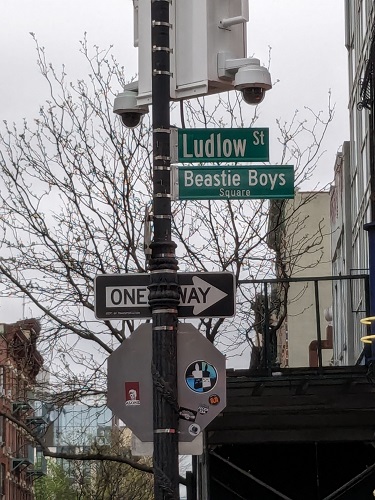
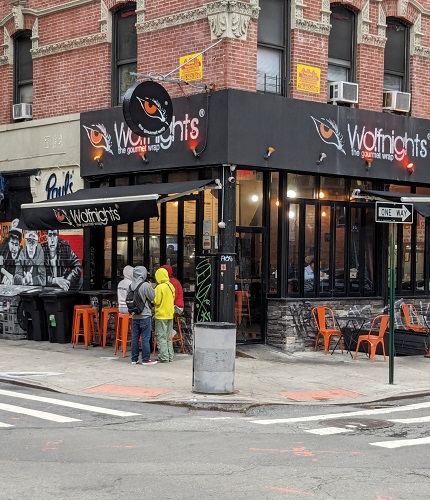
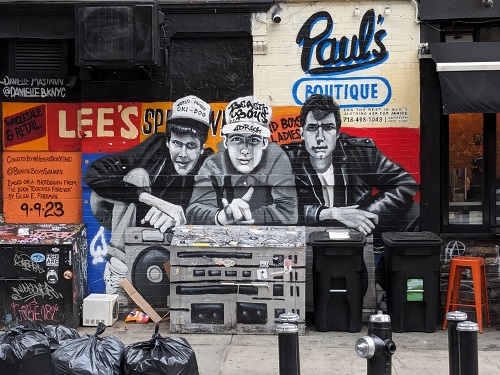
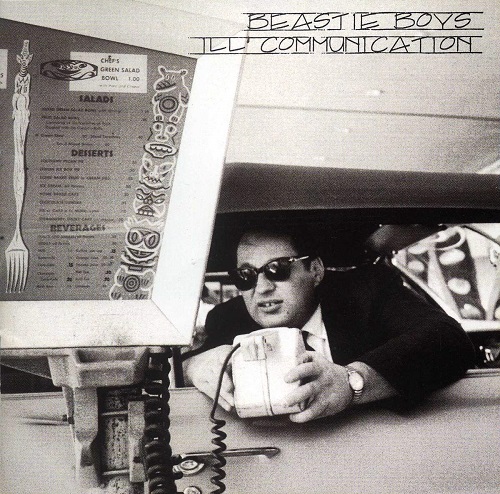
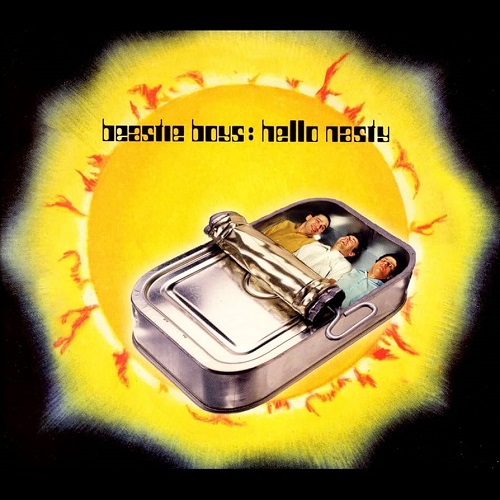
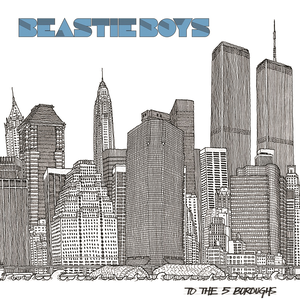
Beastie Mania – a celebration of everything & anything Beastie Boys
Beastie Boys Collection – Social Media Platforms
Andy Mackenzie grew up in St Albans and somehow still manages to afford to live there. He has been totally consumed by music since being given a pile of 7″ singles and an old record player when he was five. He can be found on Bluesky, he compiles a monthly playlist on Spotify called A Month in the Headphones and occasionally blogs at Puttin’ on the smile.
TopperPost #1,151

 Built to Spill
Built to Spill
The Beastie Boys were accorded deep respect by NWA and Run DMC. They pointed out that NWA and Run DMC sang about their lives in New York as poor black people. Beasties sang about being suburban New Jersey kids. They recognised the honesty of the stories. And using metal rather than funk helped seal the deal.
Fight for your right is one of the top 20 songs of the century and a top 10 hip hop song.
I loved how you pointed out you grew up with them. They were more like cousins to me (in that I wasn’t close but loved them anyway) but I got exactly what you were saying. A great article and list.